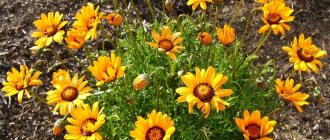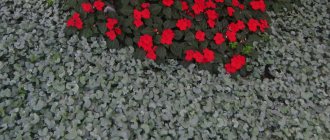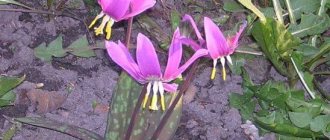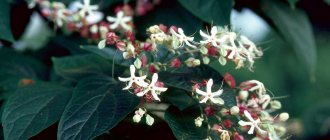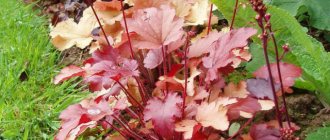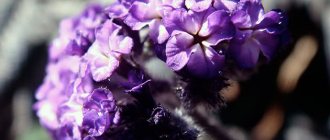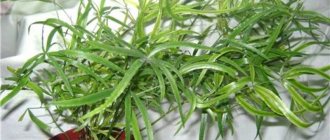Description of the coniferous plant
An interesting dwarf Christmas tree was discovered in Canada at the beginning of the last century. After a series of studies, scientists came to the conclusion that this tree appeared because Picea glauca (Canadian gray spruce) mutated. In appearance, the Canadian spruce conica looks like this:
- the crown is cone-shaped, very dense and fluffy;
- needles up to 1 cm in length of a light green shade densely cover the branches;
- in the lower (widest) tier the crown diameter averages 80 cm;
- The roots are not long, located close to the surface.
The growth of conika is very slow, young “individuals” add about 6-8 cm per year. At the age of 10-12 years, the height of the seedling is approximately 1 meter. After this peak, the growth rate noticeably decreases, and each year the height increases by only 2-3 cm. A Christmas tree can live for about 300-500 years.
Glauka Konica in landscape design
Over the years, the plant increases in size, and it becomes impossible to keep it in a pot at home. Then the bush is transplanted to the site. With age, the needles thicken, and Konika forms a dense, wide cone. This form is convenient for decorating a site and easily fits into any idea of a landscape designer.
We recommend that you familiarize yourself with the difference between Haas avocado and regular avocado.
Prickly spruce Glauka Globoza combines well with Konika: a small blue spruce fills the background well in front of a four-meter bright green plant. A mix with other dwarf spruce trees is also widely used in landscape design. A good combination with dwarf thujas, for example with western Danica.
Single and group plantings look good only with Glauka Konica spruce.
Buying a seedling in a pot
Modern trends dictate the fashion for preserving natural green spaces, so you can decorate your room for the New Year by buying a konica spruce in a pot. In order not to spoil the holiday, you should adhere to some rules.
- When installing a conic as a New Year's tree, you should find a place that will be removed from all active heat sources.
- The tree only occasionally needs to be turned towards the light.
- If the room where the Canadian guest is standing is heated, it is necessary to spray the crown from time to time.
- Wood requires increased air humidity, so it is better to place a bowl of water near it.
- At the end of the holidays, be sure to put the spruce on the balcony or loggia, since in winter this plant requires a temperature of no more than +10 degrees, and this is extremely difficult to achieve at home. Cover the top of the crown with burlap to create an optimal humidity regime for the tree. Wrap the pot with insulation to prevent the soil from freezing.
- Dwarf Canadian blue spruce conika can grow at home for the first 3-4 years so that it can finally get stronger. After this, the tree is ready to be transplanted into the open ground of the site.
Disease and pest control
You need to constantly inspect the tree to prevent any dangerous diseases or pests. A serious problem for Konica is the spruce spider mite, which first kills the needles and then the plant itself. This arthropod is very difficult to notice due to its small size, but its presence is indicated by a thin web.
Spider mites reproduce very intensively: during the growing season they produce up to five generations, each of which develops in 2-3 weeks. The pest is especially dangerous in hot weather. The treatment of spruce is repeated at least two to three times with such preparations as:
- Aktellik;
- Nurel D;
- Caesar.
Many insects can harm plant roots. These pests include mole crickets, wireworms, and various types of beetles are especially dangerous and are very difficult to control. Insecticides cannot completely destroy them, but impregnation of the soil with Aktara gives some relief.
The false scale insect infects the needles of Canadian spruce. The tree not only loses its decorative appearance, but may also die. The drugs Enzhio, Calypso and Confidor help to cope with this pest. Rust is very common on all conifers and affects the trunk and branches of the tree.
Regular preventative treatment with Falcon, Zato or Zantara helps save plants from death. Baikal EM-1 has proven itself very well in this regard. Often the cause of diseases is improper care of the Glaukonica spruce, so before purchasing a plant you need to familiarize yourself with the peculiarities of its development, as well as the rules of planting and care.
3
( 1 ratings, average: 5.00 out of 5)
Back
How to make a trellis for cucumbers with your own hands
MORE
Planting a seedling on the site
Glauca conica spruce, like all representatives of its genus, cannot tolerate drying out of the roots, so when purchasing, pay attention to seedlings that are sold in a container with moistened soil. Planting koniki spruce is the most crucial moment on which the further growth and development of the tree depends. When planting, you should adhere to the following rules:
- Planting conics in the garden should be done on a cloudy day at the end of spring.
- Choose a sunny place without drafts. In the shade, the correct shape of the crown may become distorted, and the tree will become less attractive.
- The hole for planting must be prepared in advance. The bottom should be covered with a layer of broken brick or crushed stone.
- The soil mixture should also be prepared in advance. For this purpose, a mixture of sand, garden soil, humus and peat in proportions of 1/2/1/1 is suitable. It will not be superfluous to add some mineral fertilizers, for example: Zircon, Epin.
The landing process looks like this:
- Soil is poured into the hole on top of the drainage in such an amount that the soil from the container can then fit. Waters well.
- The plant is carefully removed from the container and immersed in the prepared hole.
- The trunk is well aligned on all sides.
- The free space is filled with the prepared soil mixture.
- The filled hole is well watered; this will require about 10 liters of water.
- Finally, a small hole is created near the trunk for further watering, and the trunk itself is covered with a 5-centimeter layer of mulch (pebbles, gravel and other covering materials).
- It is better to cover the tree at first so that the unaccustomed needles do not get burned in the sun.
How to plant
The fastest way to get one or more evergreen coniferous trees on your plot is to place high-quality seedlings purchased from a nursery.
Buying a seedling
Before purchasing and planting, you need to carry out a number of activities - find a suitable place that meets the conditions for good growth, prepare the soil.
It is best to buy a plant in a nursery, where there is a guarantee that they will sell you exactly the desired variety and the tree will not be sick
The selection of seedlings is carried out according to the following rules:
- It is better to purchase a specimen that has a closed root system. It can be dropped off at any convenient time.
- If you buy a bare-rooted seedling, you should not subject it to long-term transportation. Such material must be planted immediately.
- Be sure to pay attention to the condition of the root system. Even when open, there should be a full-fledged earthen lump on it.
- During transportation, it is necessary to cover the exposed roots with damp burlap or protect them from possible damage in another convenient way.
- A thorough inspection of the purchased seedling is required to ensure that it does not have dried, diseased branches or damage.
Selecting a location
It should be sunny; the tree will not grow well in the shade. Do not plant the plant in the wind or draft.
Konica is an actively “breathing” plant, so it tolerates air pollution very poorly. For planting in urban areas, especially near busy highways, it is worth choosing another representative of conifers.
The location chosen on the site for planting the spruce also depends on the desired landscape composition
There are many options for using Konica in garden design and they involve both single and group or border planting.
Latest posts Chainsaw or electric saw - what to choose for the garden? 4 mistakes when growing tomatoes in pots that almost all housewives make Secrets of growing seedlings from the Japanese, who are very sensitive to the soil
The land in the intended square should be fertile and moderately acidic. Enrichment with organic fertilizers in the previous planting season is encouraged. Before placing the plants, the soil is carefully dug up to a state of moderate looseness. The substrate should allow good penetration of not only moisture, but also air to the roots.
Planting process
You can plant spruce outside at almost any time of the year, except winter. In the spring and autumn seasons, it is permissible to place a tree in open ground whose root system is not protected, and in the summer only seedlings with closed roots can be used.
Konica's roots are thin and do not tolerate the influence of dry hot air, so if you plant the plant in the heat with open roots, it may dry out
Stages of planting:
- At the bottom of a prepared hole of the required size, drainage is poured with a layer of about 5 cm.
- A mixture of peat, leaf soil, turf, sand with a slight addition of organic matter is prepared.
- A small mound is formed in the depths of the hole, on which the seedling is placed.
- The roots are carefully straightened and the hole is filled with prepared soil with the addition of complex fertilizer.
- A circle around the trunk is formed, which will facilitate watering.
- Immediately after planting, 12 liters of settled water are poured under one seedling.
- The tree trunk circle must be mulched with clean peat, wood chips or middle fractions of tree bark.
Video: planting spruce in open ground
Caring for decorative spruce
If you are wondering how to care for konica spruce, then care can be characterized as minimal. House conika does not require pruning, replanting or additional crown maintenance. Despite its unpretentiousness, a little proper care will additionally ensure the preservation of the beauty of the conica Christmas tree.
- In not very hot and dry summers, moisture is provided by natural precipitation.
- On hot days, water the plant regularly (as the top layer dries), while spraying the crown.
- The first two months require weekly watering. If a crust forms on top of the soil, be sure to loosen the top layer.
Attention! The tree's roots are located close to the surface of the earth. Therefore, the plant cannot easily tolerate soil compaction or trampling of the earth in an area with a diameter of 1 m around the crown.
- Sonica is resistant to frost, but, nevertheless, the first couple of years should be thoroughly mulched for the winter in the area near the trunk.
Important! Even though the tree can be grown in open ground, in the spring it can receive significant sunburn. Burns manifest themselves as browning of needles. Professional gardeners recommend wrapping the crown with material in the spring so that it diffuses the sun's rays and does not interfere with the passage of air.
Planting in open ground and care
All plants in stores are sold in a special substrate - peat. After purchase they need to be replanted. However, with proper care (moderate cold), they can survive until spring. If it is impossible to provide the fir trees with cold, then they should be immediately transplanted into a larger container, pouring normal soil into it. The root should not be touched so as not to damage it. Picea Glauka Konica is very sensitive to transplantation, which must be done only in the spring. After this, the root takes root for almost three months.
Cool, cloudy weather is required for planting in the ground. It is best to choose a place near a fence or wall so that the sun's rays do not burn the delicate needles of Konika. The tree is carefully removed from the pot and immersed in water for two hours. Then the roots are freed from the substrate, all the small roots are straightened to the sides, and the spruce is planted in a pre-dug hole. Immediately after planting, the tree is shaded from the sun with a fabric canopy throughout the summer.
The soil under the spruce is loosened and covered with dry pine needles or peat. If planting is done in the fall, the root system is not touched , only the tangled shoots are straightened. The rules for caring for Konica are simple. It is necessary to constantly monitor the soil moisture, spray the branches on hot days and regularly water the tree.
As soon as the spruce adapts a little to the place, it needs to be fed. In spring, the plant is treated with a growth stimulant to cause buds to appear. Also, once every two weeks you can apply various fertilizers to the soil to improve its composition.
Where is the best place to plant a Christmas tree?
Decorative spruce konika in open ground looks most advantageous in the most prominent areas:
- near the gazebo;
- at the entrance to the house;
- At the playground.
The dwarf guest looks great, both in single compositions and in group plantings in combination with coniferous trees of other species. The trees are especially interesting in the off-season, when at the foot there is a green lawn, creeping tenacious plants or contrasting antennae.
The plant looks beautiful when new shoots appear, as the tree turns into a bright green cone of fabulous beauty. In Russian latitudes, this period falls in May.
Konika spruce needles turn yellow - what to do?
Nobody likes it when plants begin to lose their beauty. It is important to know why Konika spruce turns yellow and what to do in such situations. This can happen as a result of:
- insufficient or excessive watering;
- improper landing;
- exposure to direct sunlight;
- pest or disease infestations.
Before you panic and get rid of the plant, you need to determine the exact cause of the wilting. If the problem is violations of growing or care conditions, then everything needs to be changed for the better. To get rid of diseases or pests, you need to select a suitable product and carry out the treatment according to the information indicated on the label. For the result, it is important to follow the rules exactly.
The most common diseases of Canadian spruce
Decorative conika spruce can be affected by various infections, and only timely detection of sores and their immediate treatment can save it.
- Rust—orange growths begin to appear on the branches, and the needles quickly turn yellow and fall off. The photo shows how badly the tree can suffer. Treatment of the crown with special preparations such as “Vectra” and “Glyokladin” for a month, once a week, is suitable as a treatment.
- Schutte's disease is caused by a fungus. The needles darken, then become covered with a whitish coating and fall off. Initially, you can save the tree by spraying it with a solution of copper sulfate, then treating it with Trichodermin and Alirin-B, and in advanced situations all that remains is to dig up and burn the seedling.
Reviews about growing Christmas trees
Reviews about the features of growing dwarf spruce are mostly positive.
- Elena: I studied the description and features of caring for wood and decided to try it. As soon as the New Year passed, we immediately took the Christmas tree out onto the balcony, since at home the conica began to wither and get sick. On the balcony she quickly came to life. Now we protect only from severe frosts.
- Evgeniya: I have long wanted an exotic indoor flower. They gave me a konica. I thought it was possible to raise her in a room on a permanent basis, but it didn’t work out. In winter, the plant needs low temperatures, and I don’t have a balcony. I couldn’t save it; it disappeared from the room.
- Irina: In the spring, conica got sunburn because I planted a fragile plant in the ground early. I barely saved it; I had to remove the damaged branches. Now the sores have healed, hints of new needles have appeared.
The dwarf growth of the mutated Christmas tree turned out to be a special advantage for the Canadian guest. Such an ornamental plant will decorate every area, and its ease of care will make it accessible to everyone to grow. If you have any tips or tricks for beginners, be sure to share them in the comments.

